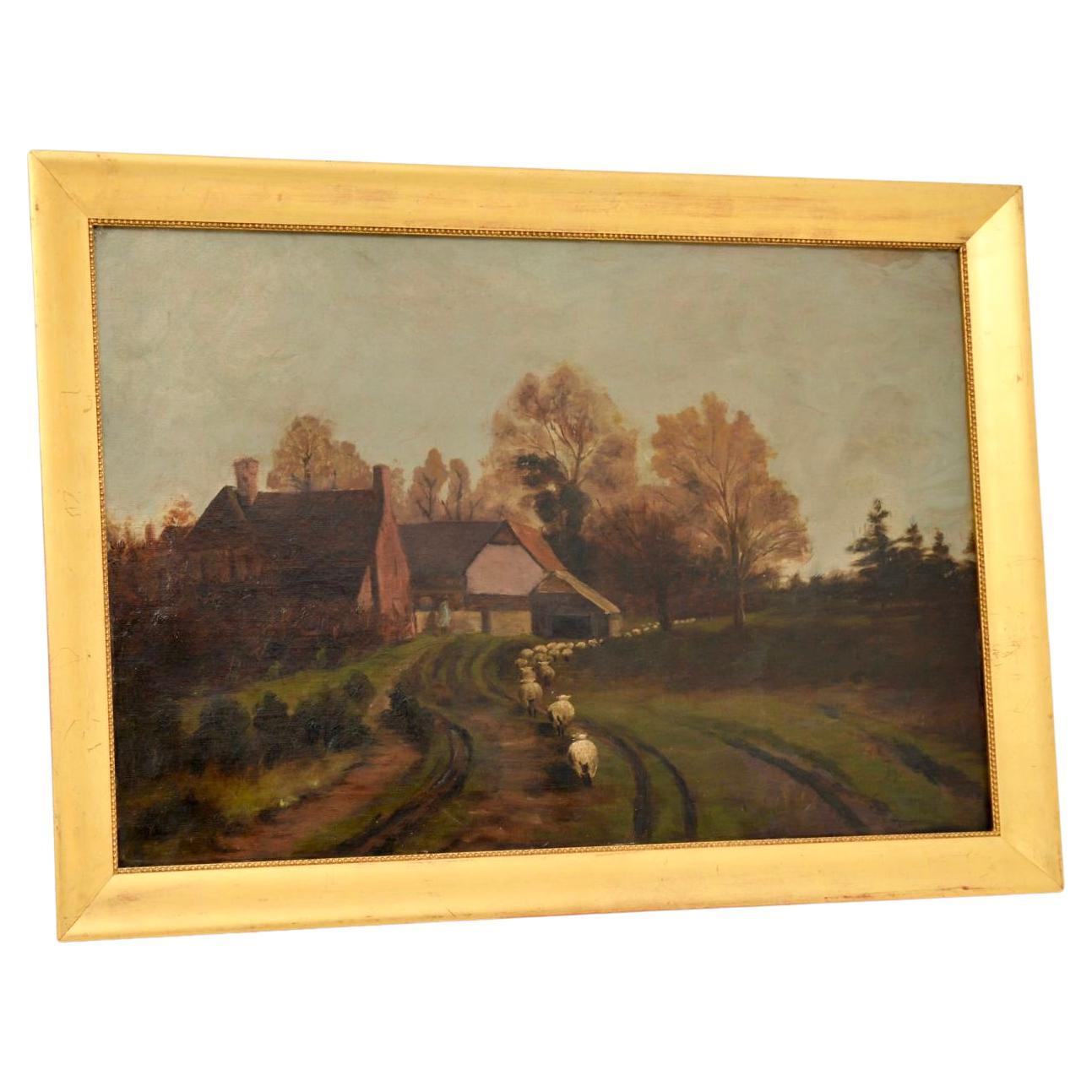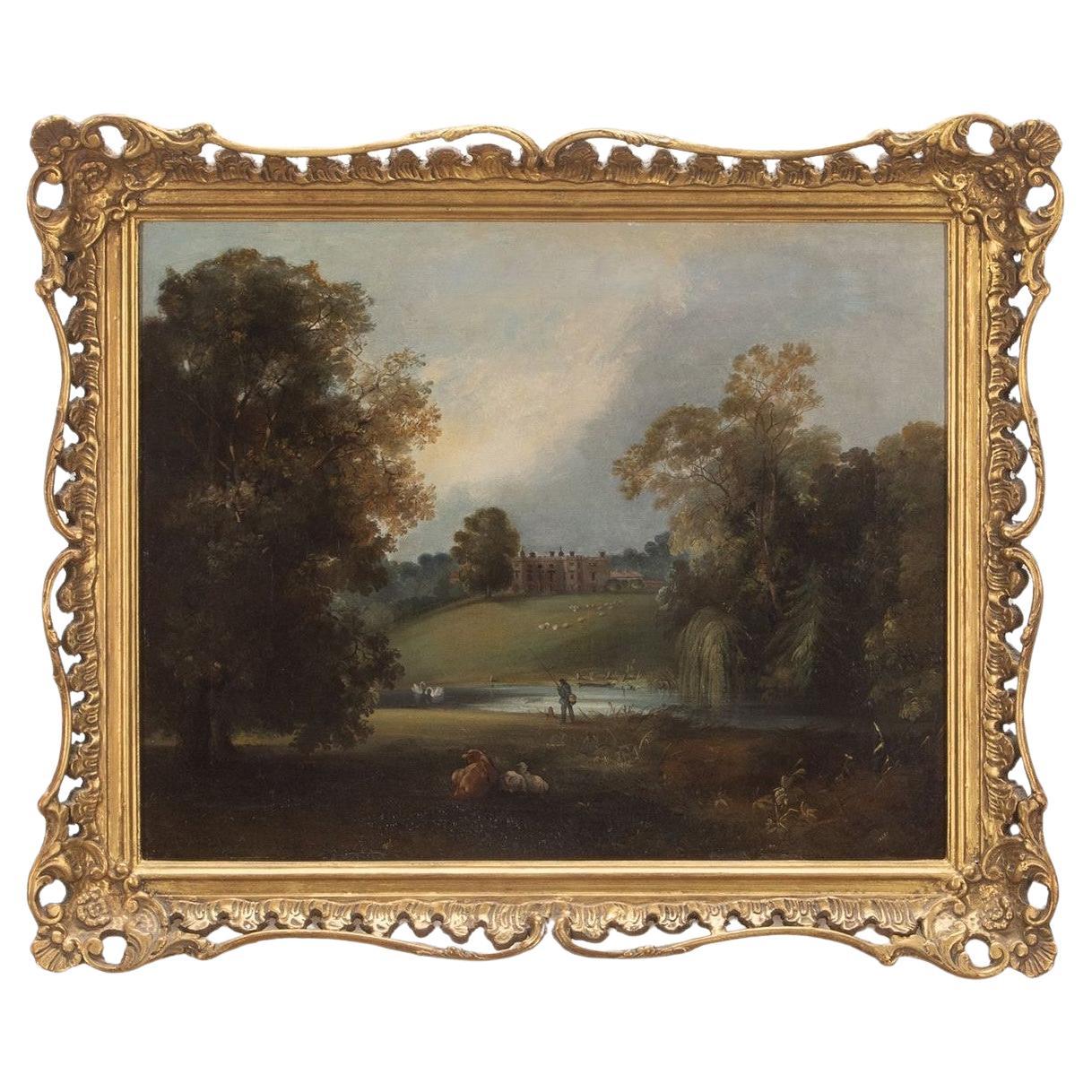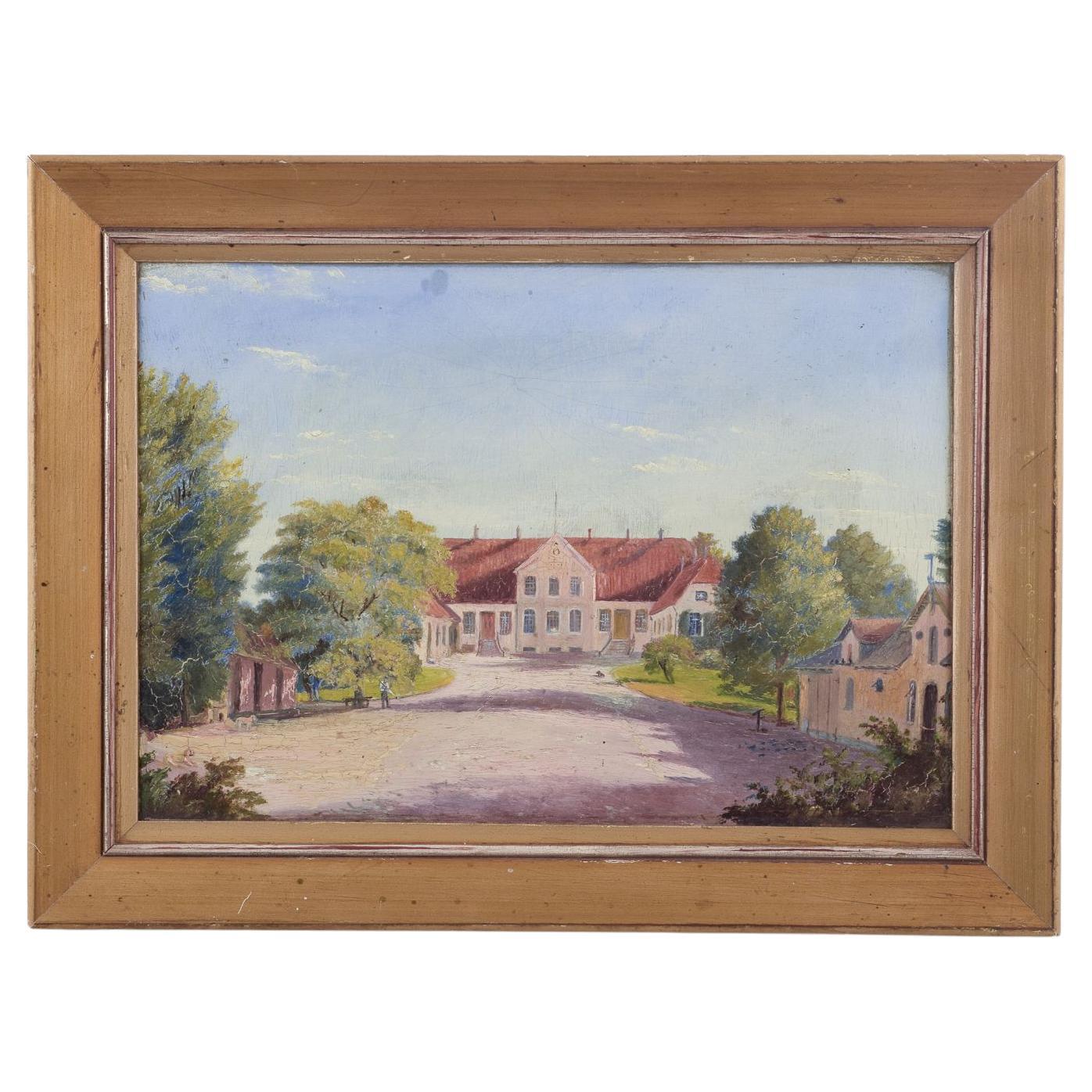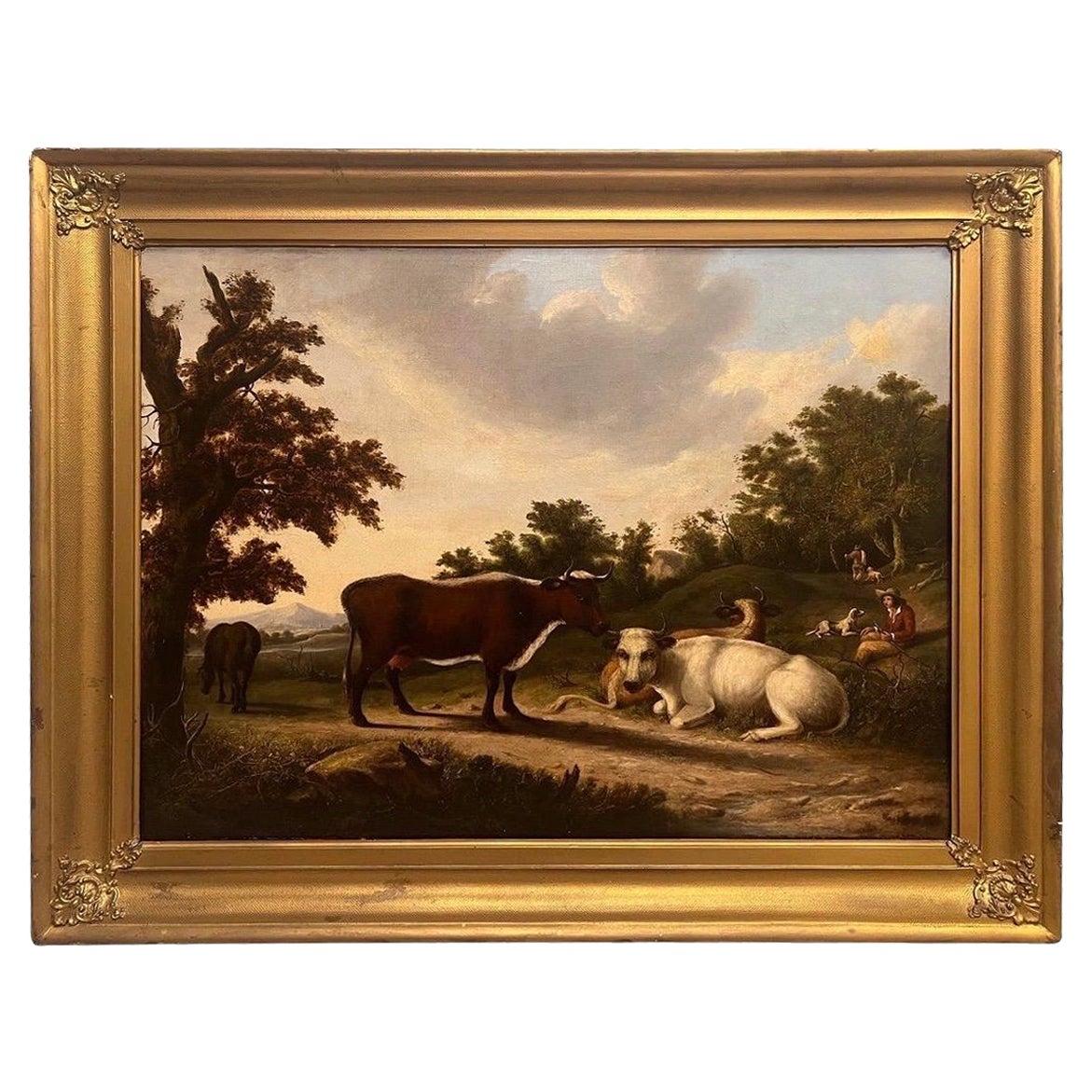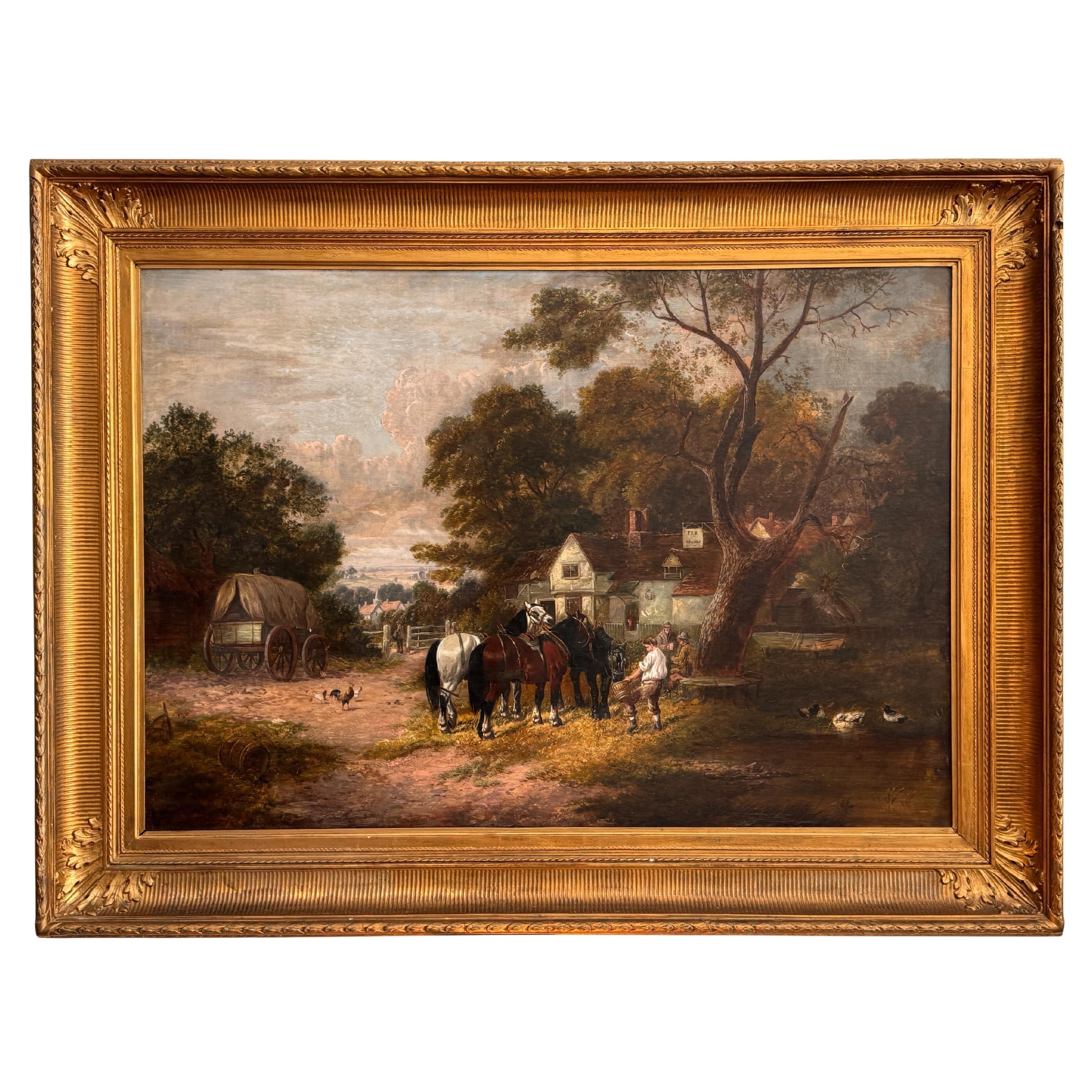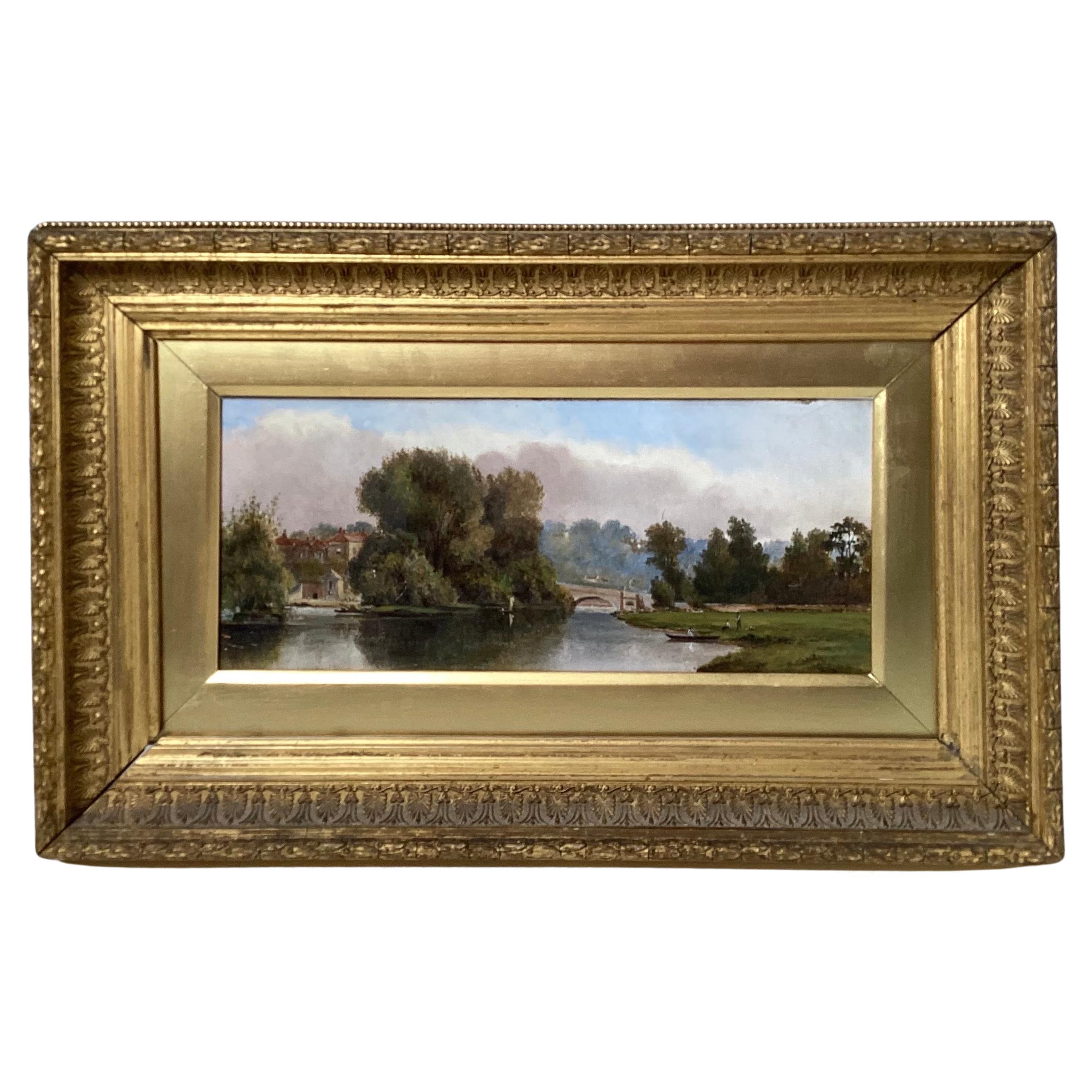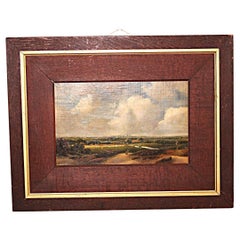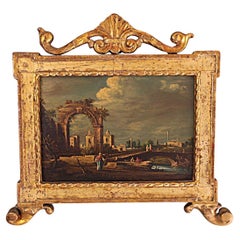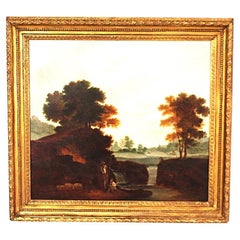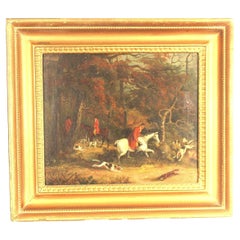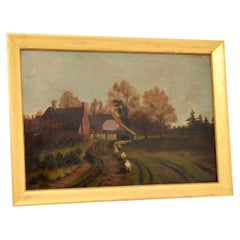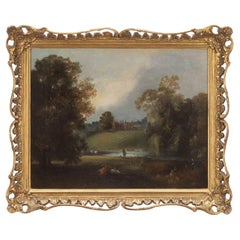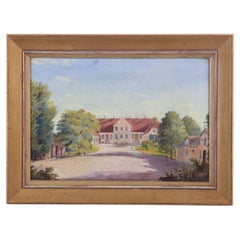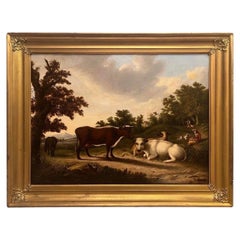Items Similar to English School 19th Century Country House Landscape Oil Painting
Want more images or videos?
Request additional images or videos from the seller
1 of 18
English School 19th Century Country House Landscape Oil Painting
$2,147.21
$2,684.0120% Off
£1,560
£1,95020% Off
€1,828.57
€2,285.7120% Off
CA$2,931.35
CA$3,664.1920% Off
A$3,261.01
A$4,076.2620% Off
CHF 1,709.46
CHF 2,136.8220% Off
MX$39,848.68
MX$49,810.8620% Off
NOK 21,767.84
NOK 27,209.8020% Off
SEK 20,491.41
SEK 25,614.2620% Off
DKK 13,649.59
DKK 17,061.9920% Off
Shipping
Retrieving quote...The 1stDibs Promise:
Authenticity Guarantee,
Money-Back Guarantee,
24-Hour Cancellation
About the Item
19th-century painting of Warlies House, Essex
This captivating mid-19th-century oil on panel painting exemplifies the idyllic charm of pastoral landscapes from the period, featuring a detailed composition that highlights both the natural beauty and rural life of Warlies Park House in Waltham Abbey, Essex. A magnificent depiction of a serene countryside scene, it showcases a harmonious balance of nature and architecture, where cows graze peacefully in the foreground, lending a sense of tranquillity and nostalgia to the work. The central focus of the painting is the historic Warlies Park House, an elegant country estate framed by gently rolling hills and expansive green fields, illustrating the grandeur of the English landscape.
The artist’s keen eye for detail is evident in the careful rendering of the estate’s neoclassical architecture, complete with white columns and symmetrical windows that reflect the architectural style of 19th-century country houses. The pastoral scene with cows in the foreground draws inspiration from Victorian rural landscapes, where cattle often symbolised prosperity and the timeless relationship between humans and nature. The use of warm earth tones in the grassy plains, contrasted with the vibrant blues and whites of the sky, creates a striking visual depth and atmospheric quality. The winding path leading to the house adds a dynamic compositional element, guiding the viewer’s gaze from the peaceful rural setting to the stately home beyond.
This historic English countryside painting embodies the artistic traditions of the Romantic and Realist movements, which celebrated the beauty of nature and rural simplicity. Paintings of this style were particularly popular in the Victorian era, reflecting the growing appreciation for the countryside as a symbol of stability and harmony during the Industrial Age. In this piece, the soft brushwork and careful attention to light and shadow evoke a calm, sunlit day, where the clouds cast gentle shadows across the estate and fields, enhancing the sense of depth and realism.
The painting also offers a significant depiction of Warlies Park Estate, an important landmark in Waltham Abbey, Essex, known for its historical and architectural value. Such artworks, often commissioned or created to commemorate noble estates, serve as important records of the period’s architectural heritage and rural environments. The country estate artwork is masterfully balanced with pastoral elements, making it an ideal representation of a time when nature and human achievement were celebrated together in art.
This piece would appeal to collectors and admirers of 19th-century English countryside painting, particularly those interested in Victorian rural scenes and historic properties. Whether as a centrepiece in a traditional room or as a refined addition to an art collection, it offers timeless charm and historical significance. Its portrayal of cattle in a rural landscape aligns with the enduring themes of prosperity and rustic life. For those seeking pastoral landscape oil paintings for sale, this work stands as a remarkable example of the genre, blending architectural elegance with bucolic serenity.
Overall, this detailed landscape painting of Warlies Park House in Waltham Abbey is a quintessential Victorian-era rural landscape. It reflects the grandeur of English estates and the peaceful beauty of the natural world. Its combination of historic architecture, rich colour palette, and lifelike representation of livestock makes it an evocative tribute to the splendour of the British landscape art tradition.
Warlies Park House, located in Waltham Abbey, Essex, is a historic country house with a rich history dating back to the 18th and 19th centuries. It is renowned for its architectural elegance and its association with notable figures and events in Britain.
- Dimensions:Height: 23.23 in (59 cm)Width: 16.93 in (43 cm)Depth: 1.19 in (3 cm)
- Style:Victorian (Of the Period)
- Materials and Techniques:
- Place of Origin:
- Period:
- Date of Manufacture:1880
- Condition:Wear consistent with age and use.
- Seller Location:Seaford, GB
- Reference Number:1stDibs: LU10376244683912
About the Seller
New to 1stDibs
Joined in the past six months.
No Reviews Yet
Vetted Professional Seller
Every seller passes strict standards for authenticity and reliability
Established in 2021
1stDibs seller since 2025
Typical response time: 1 hour
- ShippingRetrieving quote...Shipping from: Seaford, United Kingdom
- Return Policy
Authenticity Guarantee
In the unlikely event there’s an issue with an item’s authenticity, contact us within 1 year for a full refund. DetailsMoney-Back Guarantee
If your item is not as described, is damaged in transit, or does not arrive, contact us within 7 days for a full refund. Details24-Hour Cancellation
You have a 24-hour grace period in which to reconsider your purchase, with no questions asked.Vetted Professional Sellers
Our world-class sellers must adhere to strict standards for service and quality, maintaining the integrity of our listings.Price-Match Guarantee
If you find that a seller listed the same item for a lower price elsewhere, we’ll match it.Trusted Global Delivery
Our best-in-class carrier network provides specialized shipping options worldwide, including custom delivery.More From This Seller
View AllDutch 19th century Landscape Painting
By Andreas Schelfhout
Located in Seaford, GB
This charming oil-on-paper painting captures a serene landscape near Haarlem, evocative of Andreas Schelfhout's masterful Dutch Romantic style. The work features a quintessentially D...
Category
Antique Late 19th Century Dutch Late Victorian Paintings
Materials
Paint, Paper
Antique Venetian capriccio oil painting
Located in Seaford, GB
Francesco Guardi Venice Oil Painting – Venetian Art in the Manner of Guardi
Exquisite 19th-Century Venetian Oil Painting
Experience the timeless elegance of Venetian art with this r...
Category
Early 20th Century Paintings
Materials
Pine, Paint
$1,717 Sale Price
20% Off
18th century of circle Richard Wilson pastoral Landscape
By Richard Wilson R.A.
Located in Seaford, GB
18th-Century Richard Wilson Landscape – A Masterpiece of British Old Master Art
This 18th-century Richard Wilson landscape, attributed to the circle of Thomas Jones, is a stunning pastoral landscape oil painting that embodies the charm of Georgian-era countryside artwork. As a fine example of British old master landscape art, this piece showcases the elegance and natural beauty of the English countryside, making it a perfect addition to any collection of antique rural landscape art.
A Romantic Countryside Painting with Timeless Appeal
The composition of this romantic countryside painting is thoughtfully balanced, featuring lush greenery, rolling hills, and a tranquil sky. The English countryside oil painting...
Category
Antique 18th Century English Georgian Paintings
Materials
Canvas
Early 19th century horse painting
By Dean Wolstenholme
Located in Seaford, GB
A Timeless Depiction of the English Fox Hunt
The early 19th-century fox hunting scene, attributed to Dean Wolstenholme Elder, is a stunning representation of the aristocratic traditi...
Category
Antique 1810s English Regency Paintings
Materials
Canvas
Exquisite 19th Century English Still Life of wild flowers– Oil on Wood Panel
Located in Seaford, GB
A captivating and finely executed 19th-century English still life painting, rendered in oil on wood panel, depicting an abundant bouquet of mixed flowers in a terracotta urn. This hi...
Category
Antique 19th Century English High Victorian Paintings
Materials
Paint
Early 19th century Capriccio Brazil School Painting
Located in Seaford, GB
Rare Early 19th century Capriccio view of Rio de Janeiro Painting
Probably painted circa 1810 by one of Jean-Baptiste Debret, Italian Students.
Painted on Sailcloth.
Historical Context of Early 19th Century Portuguese Colonial Brazil
1.1 Transition from Colony to Empire
During the early 19th century, Brazil underwent a seismic shift in its political status. Originally a colony under the Portuguese Empire, the arrival of the Portuguese Royal Court in Rio de Janeiro in 1808 rapidly elevated the city’s cultural and political importance. By 1815, Brazil was declared a kingdom united with Portugal, setting the stage for the emergence of the Empire of Brazil in 1822. This period of transformation—often termed the transitional period from colony to empire—fueled a wave of artistic production in cities like Rio de Janeiro.
1.2 European Artistic Influence in Brazil
With the French Artistic Mission in Rio (initiated in 1816) and the presence of various Portuguese and European artists, Brazilian art of the early 1800s began to reflect diverse influences, from neoclassical painting to the early rumblings of romanticism. Painters such as Jean-Baptiste Debret, and Nicolas-Antoine Taunay, and local luminaries like Manuel de Araújo Porto-Alegre contributed to the fine arts tradition in Brazil. Their works featured scenes of local life, portraits of Brazilian society, and imaginative vistas—sometimes referred to as “capriccios,” in which real elements were combined with artistic liberties to create an idealized panorama.
1.3 Rio de Janeiro as Cultural and Political Hub
Rio de Janeiro, often called the Imperial capital after Brazil’s independence, was home to foundational institutions like the Imperial Academy of Fine Arts (Academia Imperial de Belas Artes). Later evolving into the Escola de Belas Artes (School of Fine Arts in Rio), these academies nurtured the talents of emerging painters, who found patronage under the Royal Court and, subsequently, the Imperial Court. The city’s significance was further enhanced by the construction of significant buildings, the modernization of infrastructure, and the mingling of European courtly customs with the traditions of local inhabitants.
. Description of the Octagonal Oil on Canvas: A Capriccio View of Rio de Janeiro
2.1 Composition and Layout
The most striking characteristic of this 19th-century Brazilian art piece is its octagonal shape, a relatively unusual format that draws the viewer’s gaze toward its centre. The composition showcases Rio de Janeiro’s shoreline in the early 1800s, brimming with merchant ships and smaller boats anchored near the shore. On the sand, there is a bustling crowd of local people—men and women carrying food and goods on their heads, loading and unloading boats, and engaging in everyday commerce. The backdrop of soaring mountains suggests Rio’s iconic topography, embodying the landscape that famously defines the city.
2.2 Architectural and Religious Landmarks
On the left side, one can discern the silhouette of a church believed to be Santa Lucia, a significant religious structure in the heart of early 19th-century Rio. This element provides viewers with a tangible reference point, linking the scene to an actual location. However, because this painting is labelled as a “capriccio,” the artist might have taken creative liberties by rearranging or amplifying certain features of the city. The melding of real and idealized elements is characteristic of these imaginative vistas.
2.3 Evoking Daily Life in Colonial Rio
One of the painting’s greatest appeals lies in its portrayal of daily life during the colonial era. Men and women from various backgrounds populate the scene. Some appear to be carrying goods on their heads, a common practice in Brazil that has persisted through different centuries. Others appear to be haggling or trading near small vessels, revealing the commercial pulse of an active port city. This focus on local people, combined with the grandeur of merchant ships, captures the tension and synergy between the every day and the extraordinary—a hallmark of Brazilian colonial painting that balances the grand narratives of empire with the rhythms of ordinary life.
2.4 An Amalgamation of Neoclassical and Romantic Influences
Although academic art in early 19th century Brazil was highly influenced by neoclassicism, the onset of romanticism can be spotted in the emotional portrayal of the sky, the lively palette, and the dramatic emphasis on nature’s beauty (the mountains, in particular). This duality reflects the fine arts tradition in Brazil during the transitional phase when artists were embracing multiple styles. As part of the School of Rio or the Rio de Janeiro school, painters often integrated academic techniques learned from European masters with emerging local subjects and influences.
3. Institutions and Artistic Movements
3.1 Imperial Academy of Fine Arts
Originally known as the Royal School of Sciences, Arts, and Crafts, the Imperial Academy of Fine Arts in Rio de Janeiro was instrumental in shaping 19th-century Brazilian art. Influential artists and teachers from Portugal, France, and other European nations congregated at the Academy, imparting their expertise to native students. As the monarchy consolidated power, the Academy enjoyed royal patronage, leading to the creation of Imperial Academy-style works that combined European academic rigour with Brazilian-themed subject matter.
3.2 Impact of the French Artistic Mission
The French Artistic Mission, which arrived in 1816, played a pivotal role in introducing advanced European artistic techniques, thereby elevating the overall quality of painting in Brazil. Artists like Jean-Baptiste Debret not only documented Brazilian society but also spearheaded the development of a local visual identity that aligned with both academicism and the national context of a blossoming empire. Debret, alongside others such as Nicolas-Antoine Taunay, mentored Brazilian artists, sowing the seeds of what would become the Brazilian academic art movement.
3.3 Religious, Historical, and Landscape Paintings
In addition to everyday scenes and historical compositions, religious iconography remained crucial throughout Portuguese colonial and imperial Brazil. Churches were omnipresent in cityscapes like Rio de Janeiro. Many colonial-era Brazilian portraits...
Category
Antique Early 19th Century Brazilian Spanish Colonial Paintings
Materials
Canvas
$2,991 Sale Price
20% Off
You May Also Like
Antique Victorian Landscape Oil Painting
Located in London, GB
A charming antique Victorian landscape oil painting. This is English, it dates from around the 1860-1880 period.
It is beauti...
Category
Antique Mid-19th Century English Victorian Paintings
Materials
Canvas, Paint
19th Century Country House Oil on Canvas
Located in Shipston-On-Stour, GB
A charming early 19th Century oil on canvas of a large country house in parkland, with sheep, cattle and a pair of swans on a river with a gentleman fishing. Circa 1830. In the manne...
Category
Antique 1830s English Country Paintings
Materials
Canvas, Giltwood, Paint
Unknown British painter. Oil on panel. Landscape with a manor house
Located in København, Copenhagen
Pre-owned goods are exempt from import duties for U.S. customers.
Therefore, no import tariffs will be applicable to your purchase.
Unknown British painter. Oil on panel.
Landscape...
Category
Early 20th Century British Modern Paintings
Materials
Other
Large Scale 19th Century English School Bucolic Landscape Oil Painting
Located in Atlanta, GA
Exceptional Large Scale 19th Century English School Bucolic Landscape Oil Painting. While there is no signature or specific attribution to the artist’s hand - it is with a doubt an e...
Category
Antique 19th Century Paintings
Materials
Canvas, Giltwood, Paint
$7,160 Sale Price
20% Off
Large Late 19th Century English Oil Landscape Painting
Located in Charlottesville, VA
A large-scale late 19th C. English oil on board painting depicting a rural tavern scene with a man watering a team of horses while others rest nearby. Rich in pastoral detail and atm...
Category
Antique Late 19th Century British Paintings
Materials
Wood, Giltwood, Paint
Antique English School Oil Painting on Board
Located in Lambertville, NJ
A scene of the Thames River near Richmond (outside of London). Unsigned, with hand written note attached verso as pictured. The elegant painting in original giltwood frame Dimensions...
Category
Antique 1860s English Victorian Paintings
Materials
Wood, Giltwood
More Ways To Browse
Harmony House Mid Century
Used Furniture Waltham
2 Drawer File Cabinet
300 Bc
African Brass Plate
Amber Glass Stopper
Angel Bed
Antelope Mount
Antique 7 Drawer Chest
Antique Alarm Clocks
Antique Beds Uk
Antique Chandler
Antique Chinese Lacquer Tray
Antique Collar Iron
Antique Enamel Compact
Antique Ikat Fabric
Antique Knitting
Antique Sandstone Sculpture
